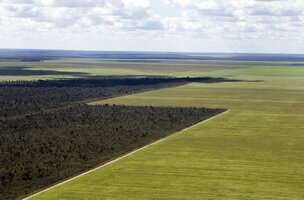Cerrado loses an area the size of London every three months

New data from the Brazilian government shows that the loss of vegetation cover in the Cerrado from August 2018 to July 2019 was 648,400 hectares, maintaining the worrying levels of recent years.
The decline is 2.26 percent less compared to the previous reporting period, but it is still alarming. Every three months, the Cerrado loses vegetation cover roughly equivalent to the size of the city of São Paulo, or the area of London. The data on Cerrado comes after the Brazilian National Institute for Space Research (INPE) recently reported an increase in deforestation of almost 30 percent in the Amazon last year and 114 percent since 2012, the year the new Forest Code went into effect.
"The Cerrado lives a silent tragedy, as it continues to be destroyed because of the lack of responsible policies. The Forest Code is not being implemented currently and even if it was, it would only protect 20 to 25 percent of the biome," said Mauricio Voivodic, CEO of WWF-Brazil.
"Today, we have 23 million hectares of open land that could be used for soy cultivation—a crop that represents more than 80 percent of agriculture in the Cerrado biome—and another 15 million hectares that are already deforested for agriculture. That's a total of 38 million hectares of land that's available for agriculture and can accommodate the expansion projected by agribusiness in the region. Currently, 22 million hectares in the Cerrado are designated for agriculture, including 18 million hectares for soy production."
The newly released data on the Cerrado indicates stabilization in the rate of loss in the last four years, at an average of 680,000 hectares per year. This means that more than half of the original area of the biome has already been converted, mainly for agricultural activities. Research also shows that only 20 percent of the vegetation that remains is in healthy conservation condition. This makes the Cerrado one of the most endangered natural biomes on the planet – research shows that the rate of destruction in recent years is moving the Cerrado towards a process of unprecedented mass extinction.
"The Brazilian federal government is giving ambiguous signals to producers: on the one hand it offers subsidies for pasture recovery and agricultural intensification; on the other, it has edited a Provisional Measure legalizing invasions of public lands that occurred until 2018, encouraging the agricultural frontier to continue expanding indefinitely and illegally over native vegetation, on untitled land," Voivodic says. "We urgently need to end this ambiguity and to give a clear signal that we will not destroy the source of wealth of society and traditional peoples and communities, that we will not jeopardize this region's unique biodiversity and that we will not compromise the cradle of water, which supplies taps, irrigates crops and moves hydroelectric turbines, generating benefits for our economy and millions of Brazilians."
Deforestation in recent years in the Cerrado has been promoted mainly by private actors, farmers and business groups, especially so-called land companies. The stabilization of deforestation rates is partly because these companies have begun to respond to their investors and buyers' call for the elimination of illegalities and deforestation.
SOS Cerrado, a collective of 150 commodity-buying companies and significant equity investor groups, has already indicated that it intends to take immediate action to decouple its supply chains and investments from the destruction of Cerrado. The first signs emerged this month: Nutreco, the world's largest animal feed company, Britain's giant supermarket chain Tesco, and animal protein company Grieg Seafood, one of the global leaders in salmon production, announced they will provide support to Cerrado soy producers that intend to expand their production without deforestation.
"Considering the social and environmental risks and loss of markets, as well as the huge open area available for productive expansion, the Brazilian government must set goals and concrete actions to reduce Cerrado deforestation and recover about 20 million hectares of environmental liabilities on existing private properties in Brazil," says Edegar de Oliveira Rosa, Director of Conservation and Restoration at WWF-Brazil.
"The government must also offer product traceability and combat illegalities by providing clarity to companies, investors and society about the origin and legality of production. The private sector must also do its part, making business conditional on eliminating crime and deforestation from supply chains and investments. Government compliance and transparency, as well as the private sector's rigor in its business, will be decisive in curbing destruction," Rosa added.
About the Cerrado
The Cerrado extends through the Brazilian states of Bahia, Goiás, Maranhão, Minas Gerais, Mato Grosso, Mato Grosso do Sul, Piauí, Paraná, Rondônia, São Paulo, Tocantins and the Federal District. After the Amazon, it is the largest biome in South America, corresponding to one-fourth of the national territory, with over 2 million km2. Demarcated protected areas are insufficient: 3.1 percent are in fully protected conservation units, 5.2 percent in sustainable use units (most without proper supervision and implementation of management plans) and 4.8 percent in 109 lands belonging to Indigenous People.
The Cerrado's protected area is considerably smaller than that of the Amazon, and the vegetation cover of the entire biome has already been reduced to about 20 percent of the original, with more than half of its territory devastated. Research has shown that if deforestation in the Cerrado continues on the current trajectory, it will lead to massive extinction of species. The biome has about 10,000 plant species, of which 44 percent are endemic, as well as a huge diversity of fauna, including species such as the maned wolf, the giant anteater and the jaguar. The Cerrado is home to 30 percent of Brazilian biodiversity and 5 percent of the planet's species. Despite this, destruction follows, and in addition to losing species, annual greenhouse gas emissions from burning and deforestation amounts to the equivalent of over 40 million cars.
Provided by WWF



















